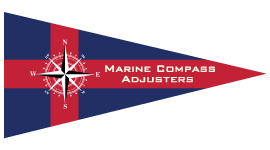Despite the modern tendency to rely heavily on Electronic Navigational Aids (ENA), the magnetic compass remains an essential navigation instrument on any sea going vessel, and continues to operate independently, in the not uncommon event of an electrical failure or electronics malfunction.
Users should be aware that ENA have limitations and have been known to provide erroneous information. Reliable and accessible alternatives for back up and cross reference should always be readily available.
Vessels are required to be equipped with a means of determining direction and heading, readable from the steering position and independent of any power supply. A correctly installed and adjusted magnetic compass, of a size and type suitable for the vessel, fulfills this requirement.
There is little doubt that Global Navigation Satellite Systems (GNSS), such as GPS, help to make modern sea travel generally safer, and for navigators, in many respects, easier than it used to be, particularly when interfaced with A.I.S., radar and electronic chart display systems such as ECDIS. It is, however, worth taking the following into consideration:
GPS is currently the only fully operational GNSS. It is owned and controlled by the U.S. Department of Defense and its commercial and recreational use is incidental to its primary, military purpose.
GNSS signals are vulnerable to loss and error, both intentional and unintentional. Malicious jamming of GNSS is a very real threat. GPS signals can be terminated or corrupted by the US military for security purposes.
Commercial GPS operates on a single frequency only. Military GPS receivers operate on a dual frequency system which is more reliable and less vulnerable to error caused by atmospheric conditions.
GNSS signals are extremely vulnerable to solar activity such as solar flares. The sun is currently entering a phase of intense solar flare activity which is due to last for several years.
Some areas of the world, particularly in the higher latitudes, have problematic or no GNSS/GPS coverage.
Other signal errors, such as multipath effect, occur locally when the signal to the antenna is reflected off nearby objects, such as superstructure, masts and funnels.
Entering the wrong antenna height into the receiver can cause significant errors. E.G. the difference between the antenna of a large vessel in ballast and sea level.
Entering the wrong datum can put the vessel’s position miles from where it really is.
Default datum used in GPS calculations is WGS84. In some areas of the world electronic chart coverage is by raster charts (scanned paper charts) alone. The datum of many raster charts is not WGS84.
When GPS shows a compass course, it is not showing the ship’s heading, it is showing the track of the vessel – where she has been in relation to her current position. With the vessel stationary, GPS will not provide any directional information.
Most electronic compasses (GPS and gyro compasses are two exceptions) are effected by magnetic deviation. They are also reliant on a power supply. Electronic compasses used for marine navigation, include:
GPS Compass – comprising 2, or preferably 3, antennas aligned symetrically fore and aft, will show the ship’s heading, in either true or magnetic form, and is normally accurate to within +/- one degree on a steady heading. As with all satellite derived data, it is vulnerable to signal error and reliant on a supply of electricity.
Fluxgate Compass – uses a number of electrical coils wound on a magnetic core to detect its alignment with the magnetic meridian. It will also detect any other magnetic fields around it and is therefore as susceptible to deviation as the standard compass.
Electro-Magnetic Resistors – used in some electronic compasses to measure the earth’s magnetic field. As the vessel changes direction or alignment with the magnetic meridian, resistance increases or decreases and is interpreted as heading.
Gyro Compass – usually fitted on larger vessels. It is set to point true north and does not use the earth’s magnetic field. It is normally accurate to +/- one or two degrees. Modern fiber optic gyro compasses are continuously corrected by computers, which are updated from GPS. It can take many hours for a gyro compass to operate correctly from the time it is switched on, or switched back on, after a power outage.
Laser and Atomic Compasses – still in early days of development for commercial marine use but may be commonplace in the not too distant future.
In Summary – State of the Art Technology can be a great asset to the modern seafarer – when it works properly. As we all know, it sometimes doesn’t, and then things can very quickly turn pear shaped. User error due to inadequate training, fatigue and “information overload” can also contribute to inaccuracies and misinterpretation of data. Over reliance on electronic navigation aids leads to complacency and sometimes to disaster.
In recent years, there have been numerous well documented occasions (and many not so well documented) on which a sudden, unexpected loss of power or the undetected inaccuracy of electronic instruments, has rapidly developed into a serious crisis. Very often, the ability and readiness to switch to old fashioned “manual” navigation, including the use of a reliable magnetic compass (and looking out of the window!), has made the difference between continuing the voyage safely and a major marine incident.
